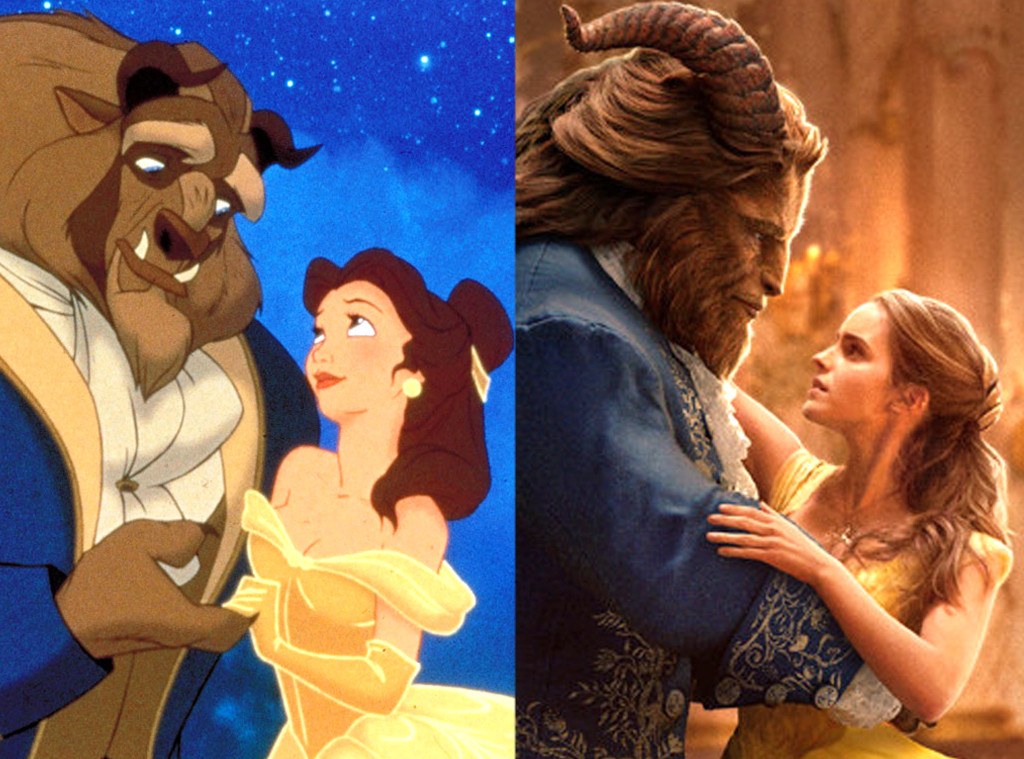
Beauty and the Beast live-action film side by side with original animation. (Photo by Entertainment Weekly)
In March of 2017, Disney will release a live-action remake of the 1991 movie “Beauty and the Beast.” Since Disney’s 2014 live-action remake of “Maleficent,” there has been a movie every year that transforms a classic Disney film into a version that has updated graphics, cast, and animations. While many fans are excited about the upcoming lineup of movies being remade, I have to stop and question if the current lineup of iconic movies needs to be touched or remade in the first place. I will look at Disney live remakes from the past, the current time, and where they’re going in the future.
In 2014, Disney decided to take a new spin on the classic film “Sleeping Beauty,” with “Maleficent.” “Maleficent” tells the story from the perspective of the Disney story’s villain. Retelling a story from the point of view of the villain was similar to the approach taken in the Broadway hit “Wicked.” While Angeline Jolie’s performance was praised by critics, the movie was not a box office success. The different perspective idea was good in theory, but the film as a whole didn’t stand up.
In 2015, Disney took the lessons that they learned with “Maleficent” and decided to retell a story that everyone already knew. They used their money and resources to remake a live-action film of “Cinderella.” While they changed a few minor aesthetics in the movie, the plot was roughly the same. In this version, they decided to cast actors that were more well-known and had to use a lot of CGI for the animals.
“Cinderella” was more of a success than “Maleficent,” and Disney decided that the winning formula to remake classics included casting well-known actors for all of the roles.
In 2016, Disney released a live-action remake of “The Jungle Book.” Since the movie was live-action, they decided to use CGI to make the animals in the movie appear life-like while having human qualities. The storyline was altered, but kept the same core elements of the original story. Disney included another well-rounded cast and the movie was another box-office hit.
Disney also released a live-action remake of “Pete’s Dragon.” The original storyline was great, but the film did not age well. Director David Lowery took the parts of what made the original “Pete’s Dragon” good, and made a more cohesive movie that holds up better than the original. It received great reviews from critics and viewers alike. This remake had high hopes from everyone that Disney was going to recreate movies that needed retelling. Instead of going that route, Disney decided to stick with their normal formula.
This year, Disney looks to release the remake of a film that is a tale as old as time, “Beauty and the Beast.” Before we can make conclusions about this movie in particular, we have to go back to the early ‘90s. The 1991 film of “Beauty and the Beast” is part of the Disney Renaissance time period. The Disney Renaissance era was between the years of 1989 to 1999, and featured a resurgence of animated films that were highly acclaimed. Such movies in this time period were “The Little Mermaid,” “Beauty and the Beast,” “Aladdin,” “The Lion King,” “Pocahontas,” “Hercules,” “Mulan,” and “Tarzan.” These movies turned the dial up to 11, and featured phenomenal animations, music, storylines, and pure family fun. “Beauty and the Beast” did some ground-breaking work in particular, and was the first animated movie to be nominated for an Oscar for Best Picture.
After Disney found the right proportions for their formula, they’ve remade movies that were released before the late 70s. While those movies were popular, they weren’t as memorable as the movies during the Disney Renaissance.
Do we need live-action remakes of classic movies? My answer is simply no. Although they have proven to be successful at the box office, incredible movies such as “Beauty and the Beast” have already left their stamp on the world, and there is no need to re-tell the story in live-action. There are limitations to live-action, such as real-world physics. Gaston swallowing eggs during his song in the bar is something that is easy in an animated movie. If Luke Evans’ version of Gaston tried to do that, there had better be a paramedic on site. Also, the magic through music and animation in the 1991 film was astounding. In “Be Our Guest,” seeing the spectacle that was anthropomorphic household items dancing to wonderful music was amazing for its time.
While this seems nit-picky, “Beauty and the Beast” is just the beginning of Disney’s road to remakes. Such remakes include “Mulan,” “The Little Mermaid,” “The Lion King,” and “Aladdin.” Remaking these movies is a shame because these movies are already solid as films. It would be as if someone wanted to re-paint the Mona Lisa. Sure, it could be done, and some people will appreciate the effort, but it won’t be as powerful and wonderful as the original. Just because someone can film a remake (live-action or animated) it doesn’t mean that they should.
Walt Disney once said, “I do not make films primarily for children. I make them for the child in all of us, whether he be six or sixty.” In today’s world, remaking groundbreaking films with more technology and human actors is not original. The child in me, and the child in most of us, loved the original movies that Disney made. Remaking already-great movies as live-action gives people nostalgia, and that’s why “Beauty and the Beast” will be successful. The story and music will be mostly the same, but it will be live-action. Though we live in a film industry where Hollywood is remaking movies every day, it is not Disney. It’s not their heart and soul. To paraphrase Cogsworth from the original film, if it ain’t baroque, don’t remake it.

